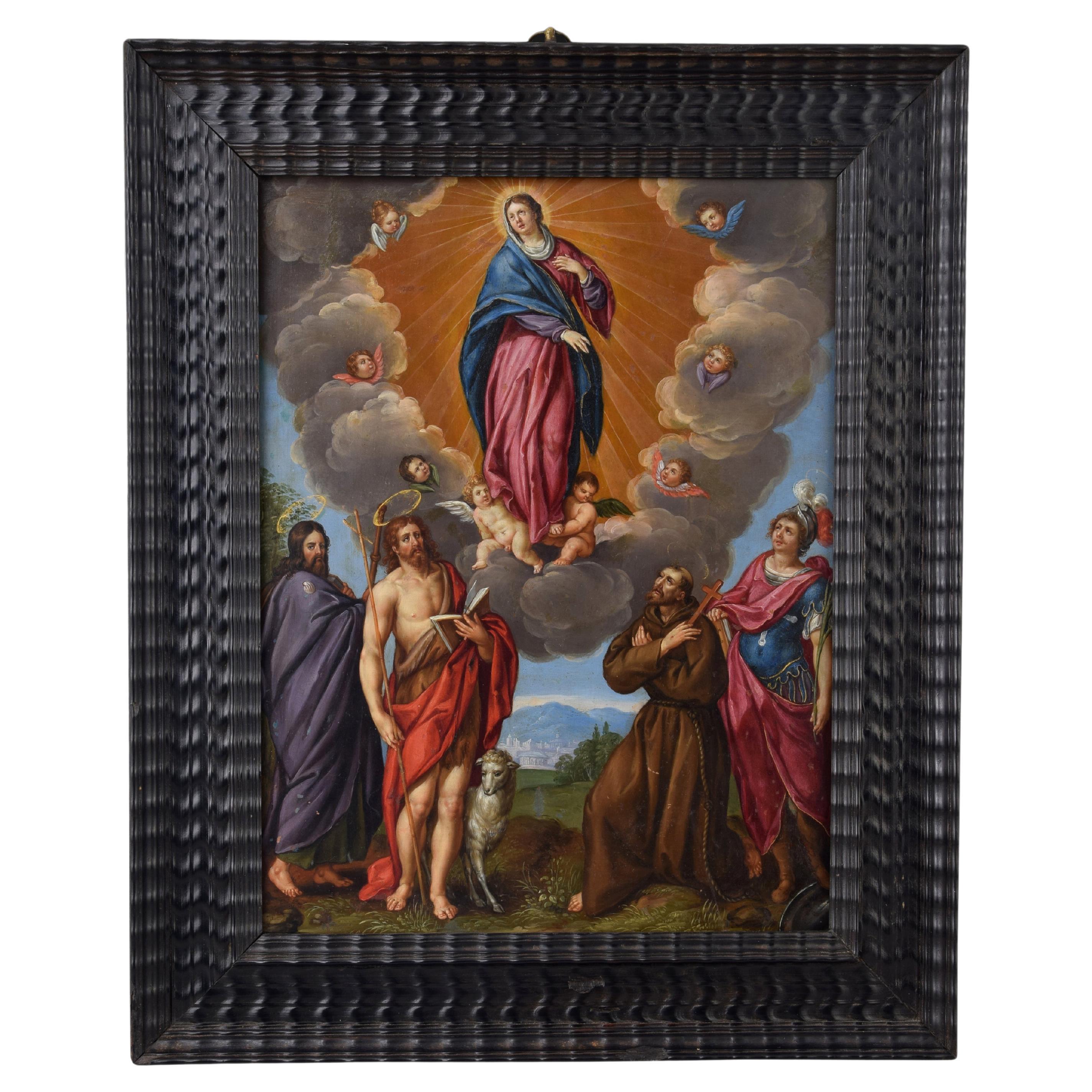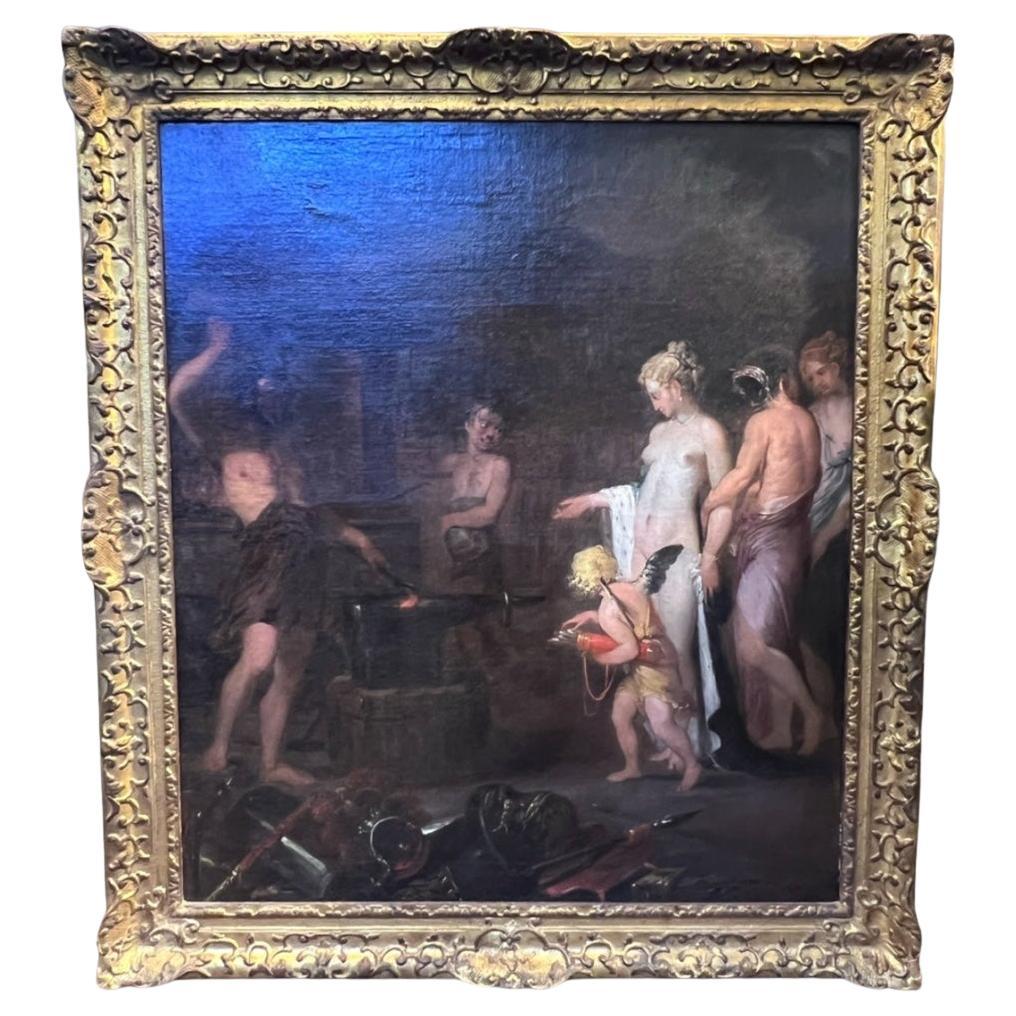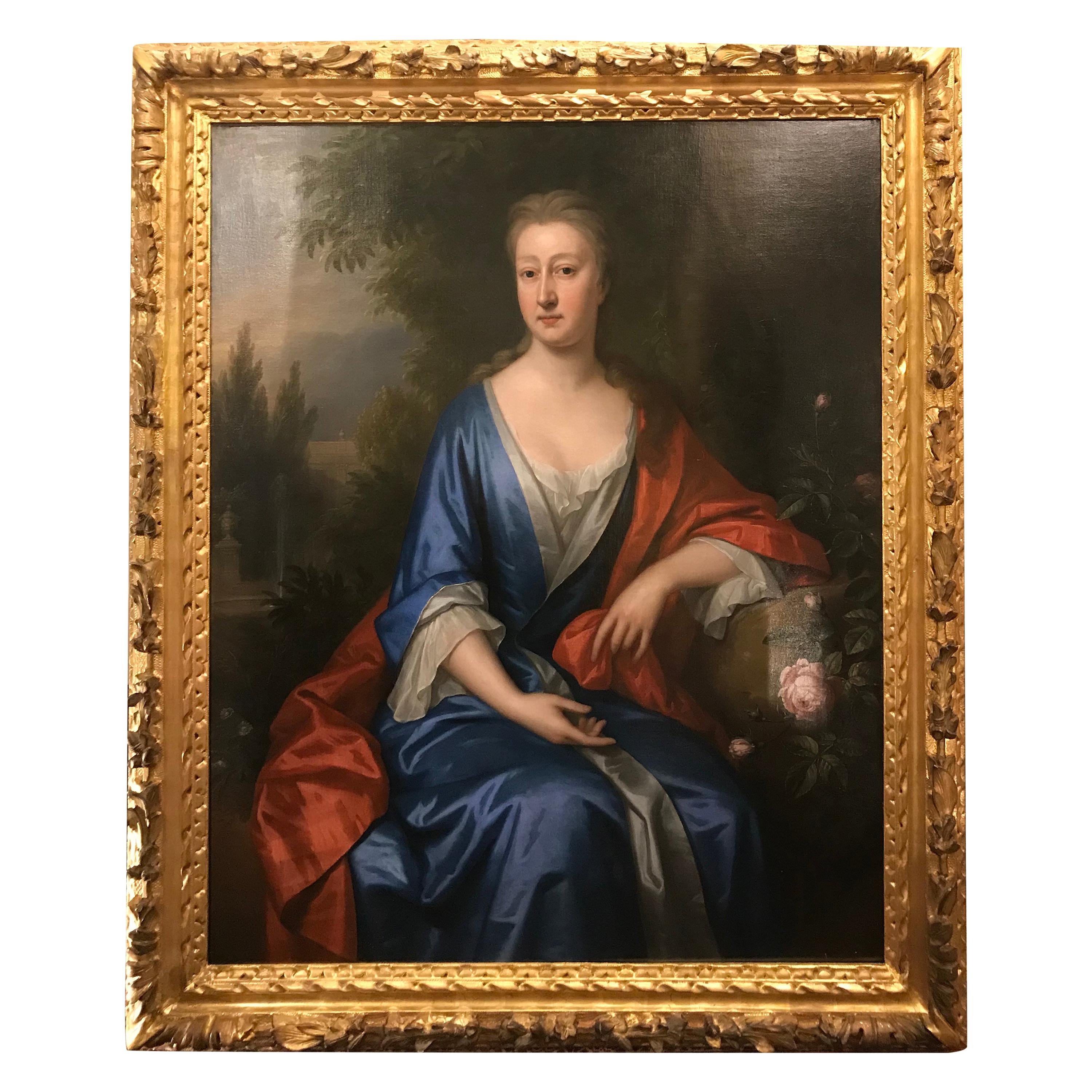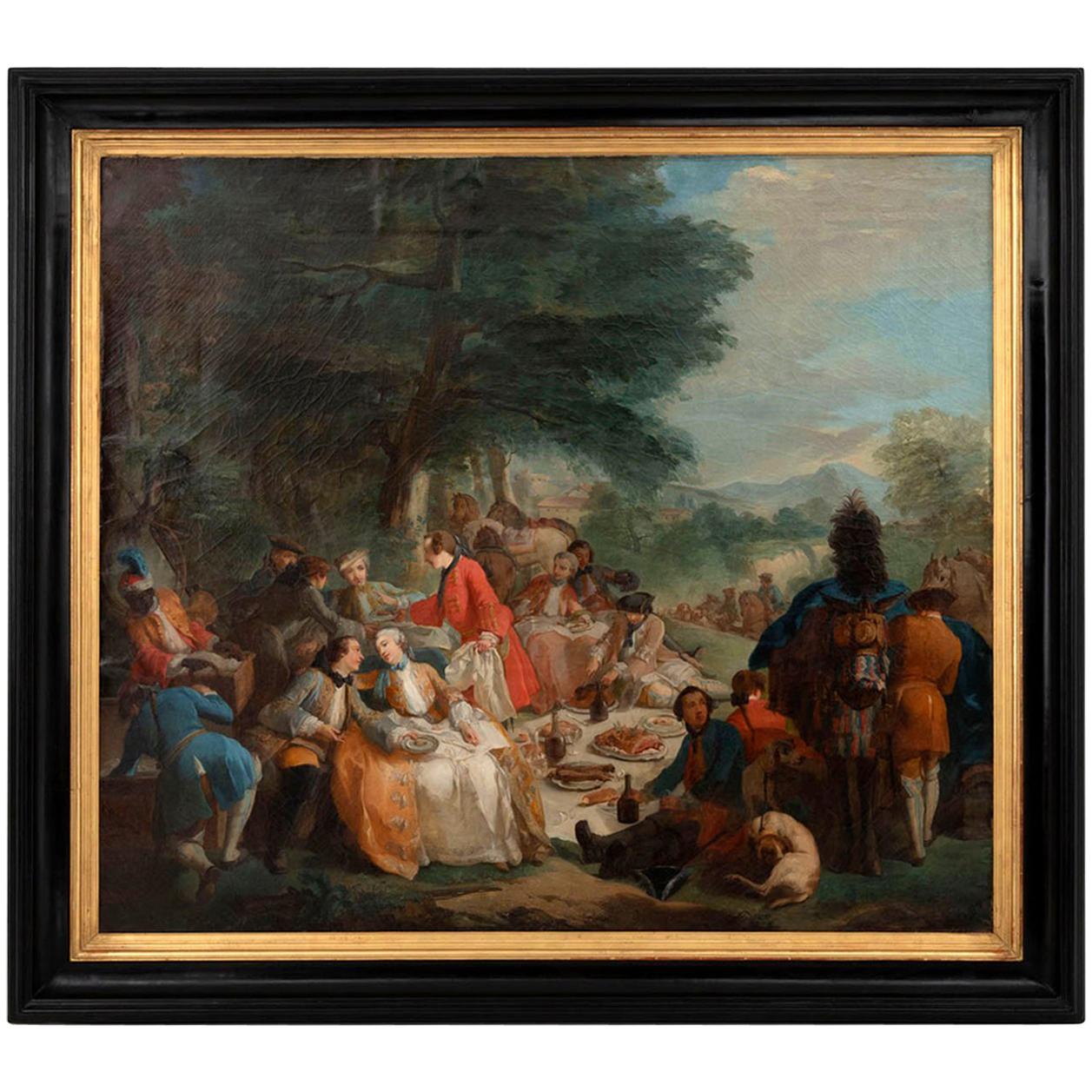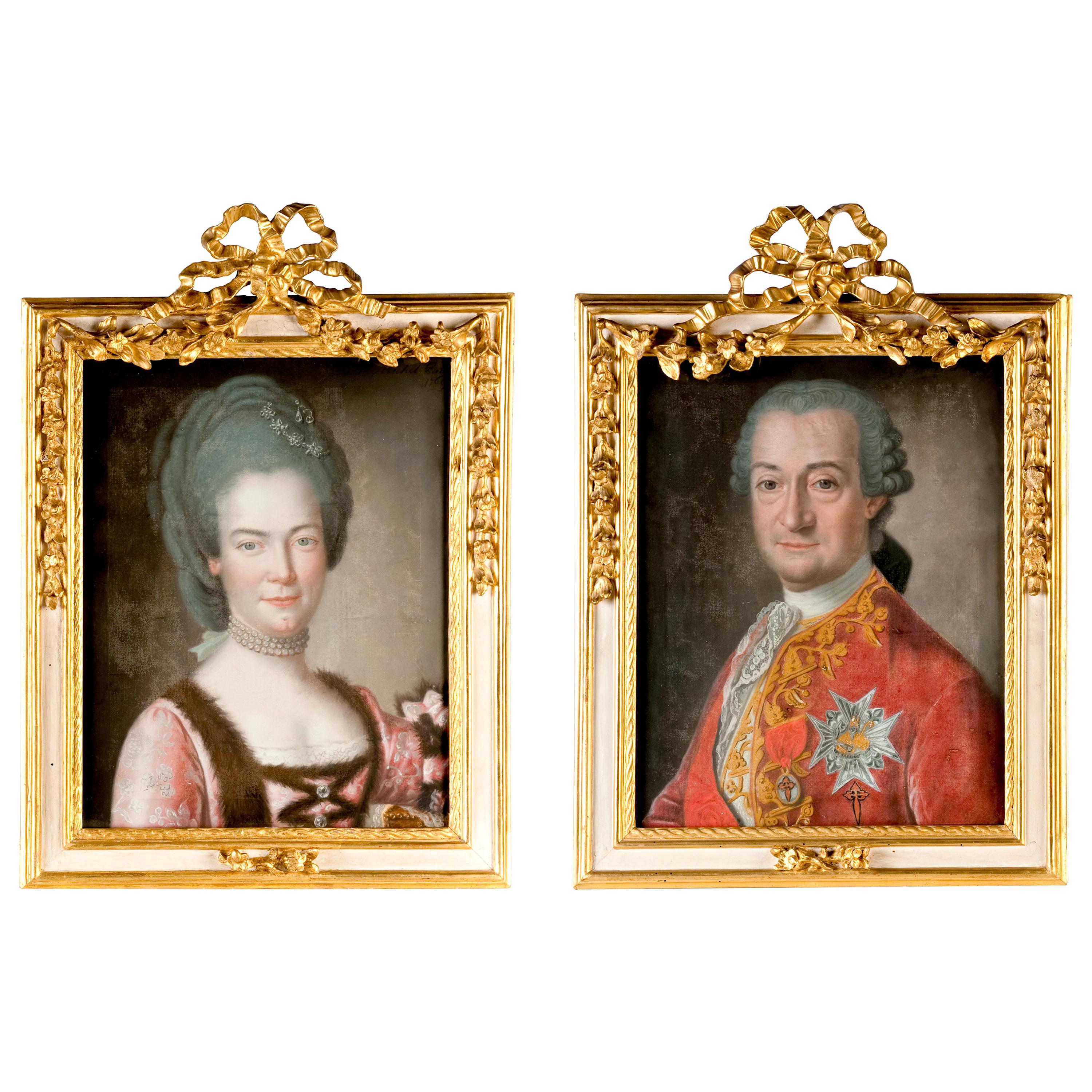Items Similar to Portrait of D. Maria Bárbara De Bragança, Circle of Louis-Michel Van Loo
Video Loading
Want more images or videos?
Request additional images or videos from the seller
1 of 13
Portrait of D. Maria Bárbara De Bragança, Circle of Louis-Michel Van Loo
About the Item
PORTRAIT OF D. MARIA BÁRBARA DE BRAGANÇA (1711-1758), QUEEN OF SPAIN
Circle of Louis-Michel van Loo (1707-1771)
Oil on canvas
Her Royal Highness, the Infanta Maria Barbara of Braganza (1711-1758) was the first-born child of King John V of Portugal (1689-1750) and his queen consort Maria Anna of Austria (1683-1754). Born in December 1711, she had the Convent Palace of Mafra built in her honour following a vow made by her royal father. Her status as Princess of Brazil, inherent to 18th century Portuguese presumptive heirs, would however be superseded once the queen gave birth to two male princes, D. Pedro (1712-1714) and D. José (1714-1777), preventing her from ascending to the throne.
Daughter of one of the most illustrious monarchs of his time, Maria Barbara was carefully educated to become a fond admirer of the arts, and of music in particular, having had the Italian composer Domenico Scarlatti (1685-1757) as her music teacher.
On the 10th January 1723 the young princess was betrothed to the Infante Ferdinand of Spain (1713-1759), eldest son of King Philip V (1683-1746). Six years later, on the 19th January, she entered her new country in a carefully choreographed ceremony that became known to history as the “Exchange of the Princesses”. This unique event took place on a specially built Bridge-Palace, a wooden, luxuriously decorated structure that included various modules and rooms, on both banks of the river Caia, the natural border between the town of Elvas in Portugal and of Badajoz in Spain. Simultaneously, on the same day that the Portuguese Infanta crossed the border to marry the Spanish Crown Prince, her new sister in law, the Infanta Mariana Victoria of Bourbon (1718-1781), her husband’s sister, crossed the same bridge in the opposite direction to marry Prince D. José, the Portuguese heir to the throne.
Once married, Maria Barbara would spend 17 years as Princess of Asturias, only becoming Queen of Spain at her husband’s accession following the death of Philip V in 1746. She is portrayed in the 1743 painting by Louis-Michel van Loo (1707-1771) now in the Prado Museum, in which Philip V had himself represented with all his close family.
The new Queen would take an important role at court eventually becoming the liaison between her husband and the King of Portugal, particularly throughout the negotiations for the Treaty of Madrid (1746-1750). Maintaining her interest in music, she patronized the Italian castrato singer Farinelli (1705-1782) while remaining close to her old master Scarlatti, having herself composed some sonatas for a large orchestra. She would also commission and fund the building of the Royal Salesians Monastery complex in central Madrid, where both her and Ferdinand VI are buried.
The portrait we are presenting for sale shows the Queen in half-length, turning left at three quarters. She is wearing a blue low-cut dress embroidered with flowers and foliage, over a lace cuffed white blouse, and an ermine cloak pined on the left-hand side by a diamond broach. The powdered hair style is held sideways by a seven diamond and black plume headdress and topped by a small gold and pearl crown. The right arm rests on a cushion while the left hand, at chest height, holds a miniature male portrait.
The Infanta’s features are analogous to the 1725 portrait by the painter Domenico Duprà (1689-1770), also in the Prado Museum collection. Further similarities can be found in another portrait by Louis-Michel van Loo, in which a seven diamond and black plume headdress is also present. In this work, the cushion supporting Maria Barbara’s right arm has also some obvious similarities to our painting. The same diamond headdress reappears in Van Loo’s above-mentioned portrait of Philip V’s family dated from 1743.
It is nevertheless in Lisbon’s Ajuda National Palace that it is possible to find an almost identical depiction of the Infanta holding a miniature portrait of her husband. In it, the future Ferdinand VI is portrayed facing right at three quarters and wearing a curly wig, suit of armour, the golden fleece insignia and a blue band, in a composition that closely resembles an 18th century Spanish school painting that appeared in the art market in January 2016.
Another detail common to various portraits of the Portuguese Infanta and Queen of Spain is the small gold and pearl crown on her head. In another Van Loo painting, also from the Prado Museum, in which Maria Barbara is portrayed as Queen, this crown is represented together with a headdress similar to the one previously described. Another two paintings by the same artist, at the Royal Academy of Saint Ferdinand, include the same ornament.
We must also refer the paintings by the artist Jean Ranc (1674-1735). In one, dating from 1729 (Prado Museum), the Infanta is depicted outdoors holding a flower bouquet and wearing a yellow silk dress with red cloak, and a set of diamond and ruby jewellery that includes a headdress similar to the one present in our portrait. Another work by the same artist, belonging to the Complutence University of Madrid, depicts the Infanta sumptuously dressed in identical colours to our painting and wearing an elaborate headdress and diadem.
These portraits, beyond their iconographical importance as contemporary records of the Infanta and Queen Maria Barbara, are also illustrative of 18th century fashion for jewelled head dressing. Often, flowers were combined with joyful adornments, composing almost theatrical displays that would reinforce the ostentatious nature of the image. The ornamental flowers and the chromatic character of the jewels would complement the luxury of the colourful dresses in blue, crimson, green or other silk shades, in compositions whose sole purpose was to highlight a royal sitter’s wealth and power, becoming an essential statement accessory within the strict court protocols and codes of conduct.
Circle of Louis-Michel van Loo (1707-1771)
Slowly but steadily, the resolute, tranquil and dignified attitude of Renaissance and Baroque portraiture becomes artificial and presumptuous. Mid 18th century society favours elusive expression and psychological deepness, albeit limited to the face, that, with emphasis on detail, on the rich colour palette and on changing costumes and landscapes, associated to the courtliness of gestures, creates a strongly artificial environment while maintaining a highly poetic intrinsic character.
Louis-Michel van Loo followed a dynasty of famous Dutch origin artists that had settled in France. Initially taught by his father, Jean-Baptiste von Loo (1684-1745), the younger van Loo studied in Turin and Rome and frequented the Paris Academy. In Rome he worked with his uncle Charles-André van Loo (1705-1765) and become a painter for the Turin Court. In 1737 he arrived in Spain being summoned by Philip V to succeed Jean Ranc as painter of the king’s chamber.
In Madrid, his work covers the numerous Court commissions and the Royal Saint Ferdinand Fine Arts Academy, of which he was a founding member and director for the Painting department in 1752. Is production at court consisted essentially of numerous portrait paintings, often Royal gifts, in which he was assisted by students under his supervision, such as Benoit Verdot.
Louis-Michel van Loo was often considered an almost exclusive painter for the Spanish Royal family. This assumption is however a grossly mistaken appreciation of his artistic production that forgets his mythological paintings, tapestry cartoons and the various aristocratic and society portraits that he has left us. His extensive production reveals the dominance of the Italian hold over the French. In his portraits, it is possible to perceive the involvement of the actors in the performance and in the pomp that corresponds to their social status. This is equally due to his chosen backgrounds of imposing architectural compositions, adorned by magnificent drapery and accessories, that contribute to creating a sumptuous atmosphere, as is evident in the current portrait.
After Philip V’s death in 1746, van Loo becomes the main painter of his successor Ferdinand VI, having painted numerous portraits of both the king and his consort Maria Barbara of Braganza. Accordingly, the various similarities between this work and others by the same painter, which portrait the same sitter, reinforce our assessment that we are facing a high-quality work by one in his close circle.
- Creator:H. van Loon (Artist)
- Dimensions:Height: 40.75 in (103.5 cm)Width: 32.88 in (83.5 cm)Depth: 1.19 in (3 cm)
- Style:Baroque (Of the Period)
- Materials and Techniques:
- Place of Origin:
- Period:
- Date of Manufacture:1707-1771
- Condition:
- Seller Location:Lisboa, PT
- Reference Number:1stDibs: LU7365234526302
About the Seller
5.0
Vetted Seller
These experienced sellers undergo a comprehensive evaluation by our team of in-house experts.
Established in 2018
1stDibs seller since 2022
10 sales on 1stDibs
- ShippingRetrieving quote...Ships From: Lisboa, Portugal
- Return PolicyA return for this item may be initiated within 14 days of delivery.
More From This SellerView All
- Portrait of Lars Gathenhielm '1689-1718' in Gilded Worked FrameLocated in Lisboa, PTEuropean workshop XVII century Portrait of Lars Gathenhielm (1689-1718) Oil on canvas Unsigned Lars Gathenhielm (1689–1718), was a Swedish sea captain, commander, shipowne...Category
Antique Late 17th Century Swedish Rococo Paintings
MaterialsCanvas
- Pair of Watercolors - Marie Louise Anne Victoire de la Fouchardière (1814-1903)Located in Lisboa, PTWatercolor paintings depicting flowers are a popular and beautiful form of art. This particular artist Marie-Louise-Anne-Victoire de la Fouchardière, used watercolors to capture th...Category
Antique Mid-19th Century French Neoclassical Paintings
MaterialsPaper
- Judgment of Solomon Painting under GlassLocated in Lisboa, PTThe Judgment of Solomon painting under glass according to an original drawing by Nicolas Poussin, dated 1649, in the Louvre Museum, Paris. Portu...Category
Antique 18th Century Portuguese Paintings
MaterialsGlass, Oak
- XX Century Wall Decoration in Style of PompeiiLocated in Lisboa, PTThe ancient city of Pompeii was founded sometime around the 7th or 6th century BCE by the Oscans, an Italic tribe that inhabited the region of Campania in what is now southern Italy....Category
Mid-20th Century European Paintings
MaterialsCanvas
- 18th Century Oil on Wood Paintings of AngelsLocated in Lisboa, PT18th Century Oil on Wood Paintings of Angels.Category
Antique 18th Century Portuguese Paintings
MaterialsOak
- Late XVIII Century Glass Painting of Sheperd on a Bucolic SceneLocated in Lisboa, PTShepherds and pastoral scenes have been popular subjects in art for centuries, appearing in various styles and mediums, including paintings, drawings, and sculptures. Artists often depicted pastoral landscapes with shepherds tending to their flocks, conveying themes of simplicity, harmony with nature, and rural life. Pastoral art...Category
Antique Late 18th Century French Paintings
MaterialsGlass, Wood
You May Also Like
- Assumption of the Virgin Mary, Circle of Van De Kasteele, FransBy Francesco da CastelloLocated in Madrid, ESCircle of VAN DE KASTEELE, Frans (Brussels, c. 1541 – Italy, 1621). "Virgin with angels and saints". Oil on copper. Curly frame in ebony. Devotiona...Category
Antique Early 17th Century Italian Baroque Paintings
MaterialsCopper
- Circle of Jacob van Loo (French, 1614-1670) - Venus at the Forge of VulcanLocated in New York, USOur oil painting on canvas depicting the Venus at the Forge of Vulcan is attributed to the circle of Jacob van Loo (French, 1614-1670). Literature: Jacob van Loo: 1614-1670; D. ...Category
Antique 17th Century French Paintings
MaterialsCanvas
- Jan van de Vaart Portrait of a LadyLocated in Lincoln, GBJan van de Vaart was a Dutch painter and draughtsman of portraits, landscapes, still life's, and trompe-lioeil paintings, and a mezzotint artist who was active in England for most of...Category
Antique 17th Century English Paintings
MaterialsPaint
- Carle Van Loo, La Halte De Chasse Oil on Canvas, 19th Century French SchoolBy Charles-André van LooLocated in Saint-Ouen, FRAfter Carle Van Loo, La halte de chasse (1737) (in english « The hunting halt »). Large oil on canvas with a black lacquered frame with gilt molded hi...Category
Antique 19th Century French Louis XV Paintings
MaterialsCanvas
- Pair of Italian Rococo Pastels on Silk Portraits by Joseph De Saint Michel, 1769By Joseph de Saint-MichelLocated in Milano, ITJoseph Comte de Saint Michel (Turin, news between 1756 and 1790; between 1756 and 1776 active at the court of the King of Sardinia in Turin) Portrait of a Gentleman - Portrait of a L...Category
Antique 1760s Italian Rococo Paintings
MaterialsSilk, Wood
- Miniature Portrait of a Sleepy Eyed Man, Circle Christian Wilhelm Ernst DietrichBy Christian Wilhelm DietrichLocated in West Palm Beach, FLMiniature portrait of a sleepy eyed man, circle Christian Wilhelm Ernst Dietrich Germany 18th century, inscribed on back, refer to ph...Category
Antique 18th Century German Baroque Paintings
MaterialsCanvas, Glass, Wood
